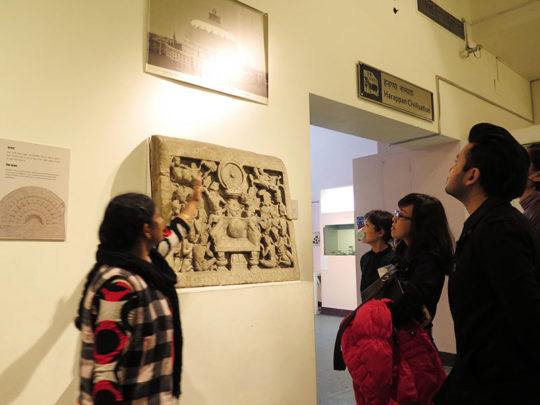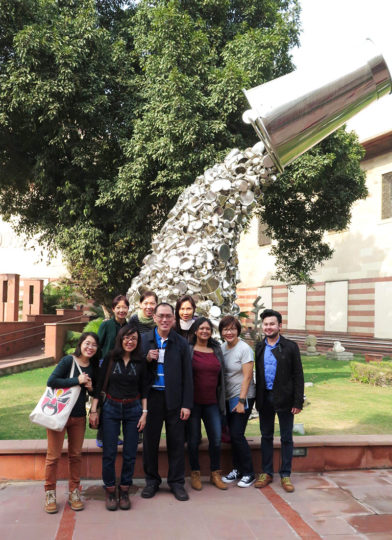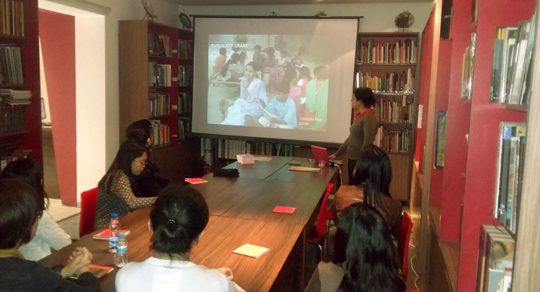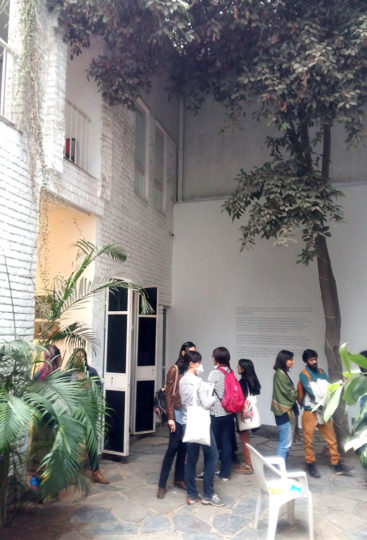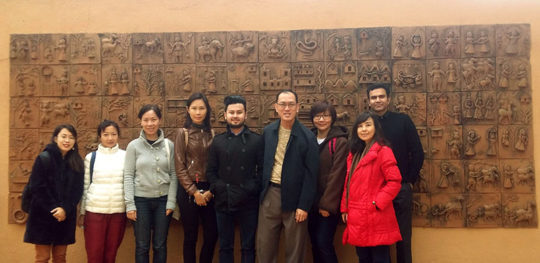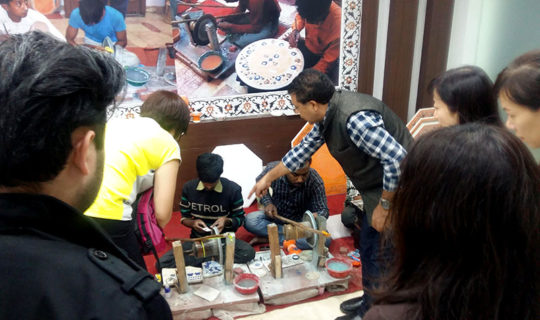by Christiaan Haridas, Hsu Chin Miao and Yeow Ju Li
There was no better place to begin our trip and introduction to Indian art history than a visit to the National Museum, New Delhi, where we were awed by the richness of the Indus Valley civilisation as seen through its collection of Harrapan, Mauryan and Buddhist artefacts, and miniature paintings (Fig. 1). There, we learnt about the iconography of Indian deities and how to identify each through their vehicles of hybrid animals. Many of us were captivated as much by the warmth of the bright smile from a sculpture of the Sun God Surya as by the physical harmony and philosophical oneness in the fused representation of the Harihara, and by the beauty of simplicity in the Dancing Girl figurine.
The visit to National Gallery of Modern Art (NGMA) was a very instructive one, given our limited knowledge of modern Indian art (Fig. 2). Many of us were all deeply impressed by the diversity and the vibrancy of India’s modern art showcased at NGMA. It was fortuitious that at the time of our visit, there was an on-going survey show of Amrita Sher Gill, known as one of India’s ‘Nine Treasured’ artists, whose works are considered national treasures and cannot be exported out of the country. We were treated to an exclusive curator’s tour and were enthralled by Amrita’s paintings. There was something magical about Amrita’s life journey that mimicked a Hollywood biopic, possibly owing to the enthusiasm of the curator and Amrita’s astonishing resemblance to Frida Kahlo. Although Amrita died at the tender age of twenty-eight, she left behind an important legacy of paintings that traced India’s intersection with Western modernity. Most appropriately, our visit ended at the gift shop where all of us rummaged for Amrita ‘souvenirs’ to immortalise her in our memories.
Our visit to Foundation of Indian Contemporary Art (FICA) was a great learning experience in terms of contributing to our understanding of contemporary art in India (Fig. 3). We saw what this self-sufficient non-profit organisation, with very little state support for the arts in India in general, can do to bring various stakeholders together and work in collaboration to enrich lives of its community members and to develop art education as a life tool. FICA is one of the few private support initiatives in India where its various annual grants supporting the arts have come to be recognised as markers of excellence in the field of contemporary visual arts in India. On top of operating a couple of art galleries, FICA is also committed to be a space for the public as it has a reading room with a library free for all to use. FICA’s bookstore was a gem for many of us who were looking for good art books to buy and quite a number of us found great art reference books for our personal interests as well as for our individual research works.
New Delhi was an extraordinary profusion of experiences for all of us, to say the least. The intensity of these new encounters and impressions culminated for one writer in our visit to KHOJ, arguably the most important independent art space in India, run by artists (Fig. 4). A short trek through the somewhat rough Khirki village led us to this oasis, where an exhibition Burning Against the Dying of the Light was ongoing, depicting the act of self-immolation by Tibetans through video installations and film. It was impossible not to reflect on the powerful messages of life and death, reinforced too poignantly as we witnessed just outside the exhibition space, a scene of crows encircling a body.
Even the business model of KHOJ and how it could possibly survive and flourish in its environs inspired some serious reflection. Similar to FICA, KHOJ is a fine example of how a responsive arts community and the private sector in India stepped in to buttress state support for the arts, by adopting a funding system that alleviates them from the entanglement of state and corporate dictation. Established Indian artists such as Anish Kapoor and Subodh Gupta, who had previously benefitted from the emerging artist platform at KHOJ, contribute to its financial sustainability by donating works to the organisation which had nurtured them. Using a trust fund model, the works are then consigned to Christie’s auction house to generate funding for the organisation.
Mimicking the ‘swag’ of New York’s East Village galleries, commercial art gallery, Delhi Art Gallery or DAG Modern, is situated within the ultra-hip neighbourhood of Hauz Khas Village where you can find trendy Indian youths looking for an epic night out. Upon entering, we were astounded by its sleek interior and museum-like presentation format. We were even more excited when we saw that DAG was currently showing an exhibition of Santiniketan, the site of one of India’s most influential arts institutions. We had discussed Santiniketan in class and to see firest-hand the works of artists who were closely associated with the institution, such as Rabindranath Tagore and Nalandal Bose, made art history truly relevant and alive for us.
One of the most beautiful museum spaces we had visited over this trip had to be the Sanskriti Museums, which houses three specialised museums namely the Museum of Everyday Art of India, the Museum of Indian Terracotta and the Museum of Indian Textiles (Fig. 5). This beautiful compound consists of five acres of land with hundreds of trees and shrubs, truly an oasis for the creativity community. On the day of our visit, it was significantly colder than the rest of our trip and was misty. The learning of Indian art and culture with a knowledgeable museum guide was great at Sanskriti; however, the piping hot Chai tea infused with cloves and ginger to go with delicious potato fritters and cumin-spiced Dutch shortbread cookies served to us at tea was what sealed our impression of the place, maybe to some extent even our impression of New Delhi since it was our last day of the trip. After all, what can beat the power of smell and taste of delicious food and spices in aiding the memory!
The visit to the Taj Mahal was definitely a highlight of our trip. Despite the long bus journey from Delhi to Agra, the trip turned out to be a comfortable one, thanks to a sophisticated expressway peppered with many amenities (the foresight of Uttar Pradesh’s Kumari Mayawati), and experiencing the Taj Mahal in the flesh made the journey all worthwhile. We marvelled over the grandeur of Mughal architecture and hard work behind the intricately inlaid marble, in surely one of the most elaborate manifestations of romantic love. Afterwards, our tour guide brought us on a mandatory stop to a shop selling objects purportedly made from the same marble that was used to make the Taj Mahal and whose craftsmen have the same inlaying pietra dura seen on the monument (Fig. 6). A couple of us brought home mementoes from the shop after some heavy bargaining.
Though the trip had seen a few glitches beyond our control, such as the three-and-a-half hour delay on our outbound flight, it certainly had its lighter moments, such as in sharing ice cold lattes with our Programme Leader Jeffrey, bargaining in Mandarin (!) with talented Indian salespersons and watching our classmate’s futile attempt to charm snakes. Regardless, the good, the bad or the unexpected, it is all part of the fun and enriching experience of travel.
All in all, the trip was not only an enjoyable and fruitful learning experience, it was an eye-opener and even a homecoming of sorts for at least one of us, as a Singaporean of Indian descent who had never visited India. Multi-faceted, multi-sensorial, multi-cultural – we each took in this richly diverse country through our own lens, and took away mementoes and memories to cherish in our own ways.
This article was written by Christiaan Haridas, Hsu Chin Miao and Yeow Ju Li, currently students of the MA Asian Art Histories Programme.


